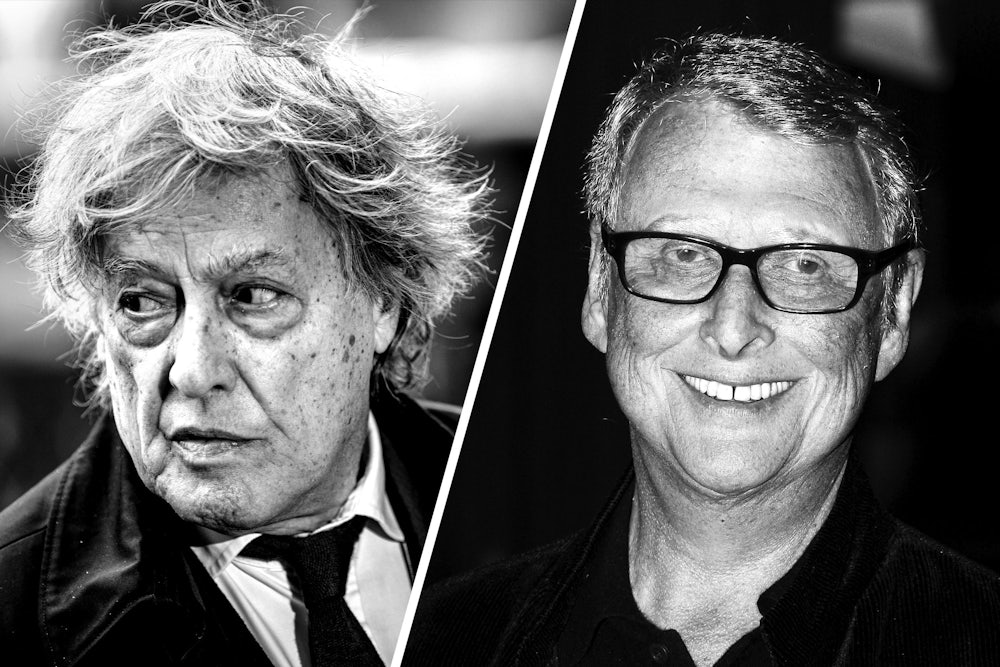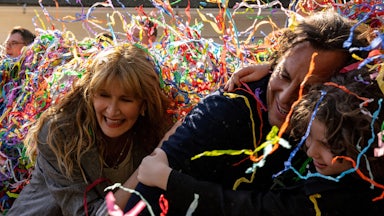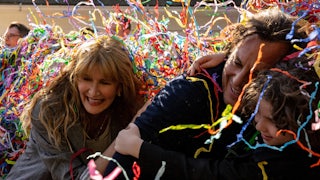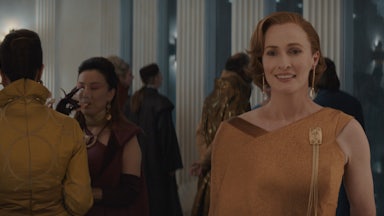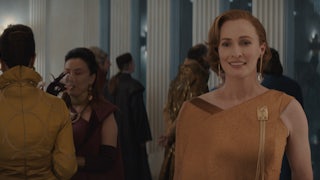In 1983, the director Mike Nichols was rehearsing Tom Stoppard’s The Real Thing on Broadway. The cast included Glenn Close, Jeremy Irons, Christine Baranski, Peter Gallagher, and Cynthia Nixon, then 17 years old. Stoppard had flown over from London for rehearsal. According to Hermione Lee’s magisterial new biography, the playwright had a note for Gallagher. Could his character “be more plangent?” Gallagher, panicked, looked at Nichols, who, according to Lee, said, “Fucked if I know.”
In Mike Nichols: A Life, Mark Harris tells this story too. But here Stoppard directs the comment at Cynthia Nixon. “A guitar is more plangent than a trumpet,” Peter Gallagher recalls Stoppard saying. “‘It’s as if you were to take a pebble and drop it into a pool from a very small height. Plangent.’ We’re Oh my god. That was plangent.”

Reading these anecdotes in two massive biographies, both published this spring, made me think about how hard it is to find the truth in any life or to balance the work and the art. It might seem unfair to compare the two books. They treat different roles in the theater on different continents—a British playwright with an enormous body of work about historical atrocities and modern consciousness and an American actor-director who once described his subject as “the relationships between men and women … centered [on] a bed.”
At 83, Stoppard is an unsentimental formal experimenter and heir to European modernism. He has written over 30 plays, including Rosencrantz and Guildenstern Are Dead (1966), Travesties (1974), and his masterpieces Arcadia (1993) and Coast of Utopia (2016). He is an adaptor (of Chekhov, among others) and author or script doctor of many screenplays, including Brazil, Empire of the Sun, and Shakespeare in Love. He is conservative in art and politics, morally serious, and unabashedly erudite. He is not a realist. “I like dialogue that is slightly more brittle than life,” he told The Paris Review in 1988. Lee’s epigraph, which quotes Arcadia, echoes Samuel Beckett, one of Stoppard’s heroes: “It’s wanting to know that makes us matter. Otherwise, we’re going out the way we came in.”
Nichols, who died in 2014, is a comic realist. He was half of the legendary comedy team Nichols and May before he directed plays, including Neil Simon’s biggest hits, and films as different as Who’s Afraid of Virginia Woolf?, The Graduate, Carnal Knowledge, Catch 22, Silkwood, and Wolf. The epigraph to this book is a devout profession of faith in stage realism, the messier the better: “In the theatre, there are only two questions … what is this, really, when it happens in life? Not what is the accepted convention … but what is it really like? And the other question we really have to ask is, ‘what happens next.’”
Yet it is striking how much these men share. Both were Jews whose families fled Hitler in 1939 and arrived in new countries and got new names. Stoppard was Tomas Straussler; Nichols was Mikhail Igor Peschowsky. Both lost their fathers as children; both did not graduate from college. Both were interested in comedy, loved the theater but made a lot of money in Hollywood, and won bundles of awards in their fields. Both smoked. Both had unhappy first marriages and joyous late ones. Both are said to have lived charmed lives, although perhaps Stoppard more than Nichols. Both loved luxury. Both did not think of themselves as Jewish artists but confronted the horror they escaped in childhood, although Stoppard more than Nichols.
The paths they each followed are telling. If you are even marginally involved in the theater, it is impossible not to envy the state support of the arts that benefited Stoppard in Britain or be angry at how, like most American directors, Nichols spent so much time chasing the dollar. Their biographers, too, take differing approaches to these lives. Harris, who is a journalist, wrote a straight chronological narrative dominated by the life. Hermione Lee, the esteemed biographer of Virginia Woolf, spends far more time on the work. Between them, we get glimpses of the possibilities of a life in art, and its limits.
At seven years old, Mike Nichols was sent to New York with his brother to join their father, who would die in 1944. He did not come from nothing. His mother’s grandmother had translated Oscar Wilde’s Salome for Richard Strauss; his cousin was Albert Einstein, a fact he thought was apocryphal for years. But Nichols had a chaotic childhood, most of all because he lost his hair after a whooping cough shot. “It was the defining aspect of his childhood,” Nichols’s brother says. He would wear toupees for the rest of his life, including one designed by Liz Taylor’s wigmaker. He did not take kindly to being told by George C. Scott to “slap on your wig and get your ass down to the theatre”; after this remark, the two would never work together again.
Young Nichols was drawn to the theater. Two legendary Broadway productions and one classic American film would influence his work for the rest of his life. He saw Elia Kazan’s 1947 staging of Tennessee Williams’s A Streetcar Named Desire and the 1949 one of Arthur Miller’s Death of a Salesman. Even more influential, a few years later, was George Stevens’s A Place in the Sun, the adaptation of Theodore Dreiser’s novel An American Tragedy, a riveting true crime story about an outsider who kills his working-class girlfriend so he can marry a beautiful heiress (played by Elizabeth Taylor, with whom Nichols would later work). Harris only explains what Nichols saw in these works briefly, with a vague quote on Streetcar: “It’s the only thing I ever saw that was 100% real and 100% poetic.” He writes that Nichols was inspired by Stevens’s camerawork. But he hardly writes about the sentimentality or the morality of these works, which seemed both to pull Nichols in and to repulse him.
In 1949, Nichols entered the University of Chicago, where Susan Sontag was also a student and his friend. She acted alongside him in Antigone and Miss Julie. Years later, she told Newsweek, “The question is: how ambitious is Mike willing to be?”—by which she meant she worried he would not direct Bertolt Brecht. (He didn’t.)
Nichols started to work with Elaine May, who was auditing classes at U. Chicago at the time. These chapters are full of delicious details. Nichols does an improvisation of Thomas Mann’s The Magic Mountain in gibberish. Nichols and May generate their perfect six-minute “Mother and Son” routine. By 1958, the duo was a smash hit. Nichols headed for the legendary Actor’s Studio in New York, where Lee Strasberg explained The Method to him, comparing it to making a fruit salad. “You will never have fruit salad until you pick up each piece, one at a time.” That fatuous-sounding advice is director gold, the point being to make every detail look real. Nichols learned other habits that would serve him well later, like insisting on rehearsal—then unheard of in Hollywood. And how, when actors are quarreling, the best thing to do is to lie them down on cots backstage in the dark and make them run their lines.
In 1961, Nichols and May broke up, and Nichols switched to directing. After making a hit out of Neil Simon’s Barefoot in the Park, he went to Hollywood, where he directed two films that would make him famous. Nichols was lonely on the booze-soaked set of Who’s Afraid of Virginia Woolf? Film seemed riskier than the theater. “You have to do it now and then move on,” he said. With the help of Richard Burton, he managed to get a great performance out of Elizabeth Taylor, who, with makeup, added weight, and a “stumpy” walk, became Martha, the college president’s daughter. At some point, the decision was made to start the screenplay a page and a half into the play, as Taylor, chewing a drumstick, rants about Bette Davis, originally considered for the role. After the movie, despite its subject and language, passed the Production Code—supposedly because Jackie Onassis was planted in the screening room with the judges and said that Jack would have loved it—it was a huge success.
The story of the making of The Graduate has been told many times, including by Harris in his 2008 book, Pictures at a Revolution. Here his most fascinating additions are the granular details of how Nichols’s decisions transformed a meh screenplay into the zeitgeist movie. After screen-testing many actors for the role of Benjamin, including Robert Redford, whom Nichols rejected because he couldn’t play a loser, he decided on the unknown Dustin Hoffman, turning a WASP into a character who was, as Nichols put it, “Jewish inside.” Although Harris does not elaborate on this insight, he does reveal plenty about Nichols’s cruelty on set, especially toward Hoffman: He made Hoffman and Anne Bancroft do 15 takes of the scene where she slaps him, which tore Hoffman’s eardrum. Harris is less willing to confront criticisms of the finished film, minimizing the objections of critics like Pauline Kael, who pointed out its slick banality.
As Nichols ages, his opportunities dwindle, films flop, youth-obsessed Hollywood loses interest, and Broadway casts him as a relic. He directs classic plays, including a star-studded Waiting for Godot. He performs in a British version of Wally Shawn’s ghoulish play The Designated Mourner. He films versions of high-profile plays for HBO, notably Wit and Angels in America. These sections of the book flag: Harris tells the reader that Nichols struggled with self-loathing but does not manage to show either his decline and his failures or his successes. Little time is spent on either his addiction to crack cocaine or his happy fourth marriage to Diane Sawyer. One of Nichols’s biggest duds, a 1992 production of Ariel Dorfman’s abstract political play Death and the Maiden, about torture in Chile, is treated largely as a power play between Dorfman and Nichols. But it was also an aesthetic issue. Dorfman’s refusal to answer the cast’s questions about whether the central character was a torturer was at odds with Nichol’s realistic American aesthetic.
Harris never does for Nichols what Nichols claims he had to do to succeed on a project—find a central metaphor. Maybe it’s unfair to say I would have liked a more reflective Nichols than Harris gives us, one who, even late in life, challenged the constraints and fads of the American theater and the limitations of his own character.
Tom Stoppard left Czechoslovakia with his parents at age two, winding up in India. Seven members of his family who stayed were killed in the camps, a fact he would not discover until 1993. He was five when his father died; his mother soon married a British man and after the war, the family moved to England. Instead of attending university, Stoppard worked as a journalist and theater critic. He read American writers like Steinbeck and Hemingway, as well as T.S. Eliot and Proust. In 1964, he began to write plays. Hermione Lee immediately links his early dislocations to his identity as an artist who would focus on temporal, ideological, scientific, and artistic dislocations. She manages to connect the seismic shifts and tragedies of the twentieth century to a great writer’s art.
From the first, Stoppard experimented with form and content to “ambush” the audience, as Lee puts it. In the early plays, he did this through comedy, threaded with grief. His first hit, in 1966, Rosencrantz and Guildenstern, takes place between the scenes of Hamlet. Critics leap into the play in The Real Inspector Hound. By the 1980s, Stoppard’s “ambushes” had grown more complex. The Real Thing (1982) starts with a play written by the central character; Hapgood (1988) is a theatrical spoof of several John Le Carré thrillers. But his ambushes were always deeply entwined with meaning. In his late fifties, he wrote what may be his most beautiful play, Arcadia (1993). It is, Lee writes, about “knowledge, sex, and love, death and pastoral, Englishness and poetry, biography and history. Not to mention chaos mathematics, iterated algorithms, Fermat’s last theorem and the second law of thermodynamics.” It is also about grief and the lust of a young girl.
Americans tended to find Stoppard cold, mannered, or too smart for the theater. During the New York production of The Real Thing, which Nichols directed, Harris quotes a moment in rehearsal when Nichols remarks, “No Tom, this scene is about you! You and your wife,” as opposed to the philosophical questions the play poses about whether bad writers can have a political impact and whether, in the twentieth century, it is possible to continue to be, as in the pop song, “a believer” in love. By contrast, Lee is persuaded by Stoppard’s opinion that his imagination plays a greater role than his biography in inspiring his work. She quotes him on his 1995 play, Indian Ink, which recalls his childhood in India. It’s “more to do with the thoughts I have had than the days I have lived.”
It was during rehearsals for Arcadia that Stoppard discovered that both of his parents were Jewish (his mother had told him that only his father was) and that many of his relatives had died in the Holocaust. In 1999, three years after his mother’s death, he wrote “On Turning Out to Be Jewish,” an essay about his astonishment at learning of this part of himself and his fear that the past arrived “too late.” His work changed, sometimes alluding to his identity, as he continued to grapple with tectonic plate–size swathes of history. In his sixties, he wrote the wildly ambitious Coast of Utopia (2002), a nine-hour, 70-character trilogy about the personal and social costs of political zealotry.
Influenced by Isaiah Berlin, it is a saga of Alexander Herzen, Sasha Bakunin, and other Russian revolutionaries and their families and the culmination of Stoppard’s lifelong obsession with, as Lee writes, “a resistance to totalizing solutions.” But the play also touches on political and personal dreams and choices—the choice between fighting at home and fleeing into exile, and the impossibility of leading a perfect life. It presents the changed world that Stoppard faced at the end of the century and refers to the changed identity that he was beginning to see in himself. In his next play, Rock and Roll (2006), the central character is a Czech Jewish boy who leaves Cambridge, where he escaped after the war, to return to Prague. Yet Rock and Roll is not autobiographical, as it veers away to engage with the 1968 Revolution and the prices and pleasures of fervors of all kinds, including those of Marxist professors.
Around 2012, after Stoppard read Daša Drndić’s novel Trieste, about the Jews who fled the Nazis before World War II and were silent about it, he began writing Leopoldstadt. (The play, which opened in London before the pandemic, will reopen in June.) More than Rock and Roll, it both is and is not autobiographical. A young Jewish man named Leo, in whom it is easy to see a stand-in for Stoppard, appears in Vienna after the Holocaust to find any surviving relatives. But, in some ways even more dramatically than Rock and Roll, Leopoldstadt opens out into a universal story about how, though we may distance ourselves from atrocity over time, the losses cannot but haunt us. On the penultimate page, the name of each relative who died and the camp where they died is read out. The word Auschwitz is repeated seven times.
A thread in both Harris’s and Lee’s books is their subject’s unknowability. Nichols is enigmatic because his life was lived in public as a famous person—the way an artist has to in order to be successful in America. Stoppard, meanwhile, seems unknowable because his work cannot be traced back to his life. It is, to quote Anton Chekhov, “an opening into eternity.”
When I finished the Stoppard biography I was filled with sadness: Reading about his late-life discovery of his ancestry makes it impossible not to wonder what could have been, what kind of person (and writer) he would have been if he had known sooner. But finishing the Nichols biography, I was frustrated. Like many artists who achieve success early, Nichols seemed to lose interest. Part of it was that he was at the mercy of the projects he was offered. They were less tantalizing, the execs were younger, their ideas about theater were limited due to ignorance or cynicism. He had to take the best of the dreck. In America, the performing arts are an “industry,” and Hollywood is a “factory.” Yet part of it was Nichols. Something slips away from him. I wanted him to run away to direct the plays of Bertolt Brecht. Of course, that could only happen in a comedy by Stoppard.
